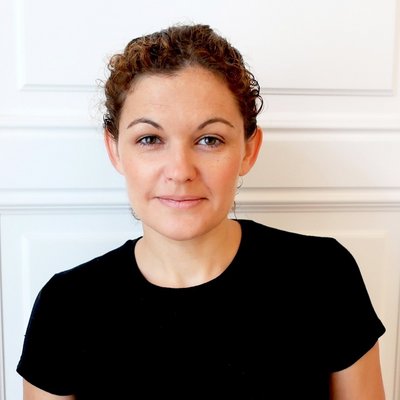Asst. Prof. Noelia Barrabés

- 1-2 Besuche pro Semester
- Bevorzugte Regionen: Burgenland, Niederösterreich, Wien (Öffentliche Erreichbarkeit vorausgesetzt).
- Bietet individuelle Besuche an
- Besucht gerne: SEK I, SEK II
- Keine anfallenden Kosten für die Schule.
Forschungsschwerpunkte
- Nanomaterials (atomically precise)
- Catalysis
- Chirality
- Spectroscopy
Aktuelle Projekte
ERC-CoG HAND: Many molecules exist in two mirror-image forms – like our right and left hands. These are called chiral molecules. Although they contain exactly the same atoms, they can behave very differently. In medicine, this difference can mean the distinction between a healing compound and a harmful one, as seen in the tragic thalidomide case of the 1950s and 60s.
In my ERC Consolidator Grant project HAND, I am investigating how and why one of these molecular “hands” forms instead of the other. Understanding and controlling this process is one of the great challenges in chemistry.
Instead of working with traditional chiral catalysts in solution, my team and I are exploring solid catalysts made from atomically precise gold nanoclusters. These clusters, each made of exactly the same number of atoms, allow us to link their structure directly to their chiral behavior. By fixing these nanoclusters on surfaces and studying them with advanced techniques such as vibrational circular dichroism spectroscopy, we aim to observe how chirality develops during chemical reactions. Our goal is to uncover the fundamental principles that govern molecular handedness – paving the way for more efficient, sustainable, and precise methods to produce chiral molecules in the future.
DN-CHIRALNANOMAT: With CHIRALNANOMAT, my colleagues and I are exploring a new generation of chiral nanomaterials built from monolayer-protected metal nanoclusters— tiny, precisely defined particles made of noble metals surrounded by organic molecules. These materials are unique because they can express chirality (handedness) not just at the atomic level, but across multiple structural scales.
This multiscale chirality opens exciting possibilities in biomedical applications, where the distinction between left- and right-handed molecules can determine how a drug interacts with the body. By designing and understanding MPCs with tailored chiral properties, we aim to create nanomaterials that can interact selectively with biological systems — for example, as highly specific catalysts for biochemical reactions, as components for targeted drug delivery, or as tools for detecting and controlling biological chirality.
CHIRALNANOMAT brings together leading experts from academia and industry to train 13 doctoral candidates in this interdisciplinary field. Through a combination of chemical synthesis, advanced spectroscopy, and theoretical modeling, they will uncover how chirality arises at the nanoscale and how it influences interactions with biomolecules.
Ultimately, our goal is to translate atomic-level understanding into real biomedical innovations — paving the way for safer drugs, smarter therapies, and new diagnostic technologies based on the power of chirality in nanomaterials.
Desnitrification of waters for ammonia production: In this project, we explore how atomically precise gold nanoclusters can be used to convert nitrate (NO₃⁻)—a common water pollutant—into ammonia (NH₃), an important chemical and potential green fuel. This reaction, known as electrocatalytic nitrate reduction (NO₃RR), offers a dual benefit: purifying contaminated water while producing a valuable product.
To achieve this, we anchor the gold nanoclusters onto layered double hydroxides (LDHs), materials that stabilize the clusters and enhance charge transfer during the reaction. By fine-tuning how the clusters interact with the LDH surface, we can improve both the efficiency and selectivity of ammonia formation.
Our goal is to understand how the atomic structure and immobilization of the nanoclusters influence their performance, paving the way for sustainable technologies that transform waste into useful resources and contribute to clean water and circular chemistry.
Auszug aus dem wissenschaftlichen Werdegang
My career started with a strong background in Chemical Engineering, then I moved to Physical Chemistry for my PhD, where I focused on developing nanostructured materials that were highly active and selective in environmental catalytic processes. This work led to several high-impact publications and earned me two prestigious PhD awards, including one from the Spanish Catalysis Society. Following my PhD, I successfully secured competitive research funding through multiple esteemed grants (IEF Marie Curie, SNSF Marie Heim Vögtlin, and FWF Elise Richter), allowing me to work independently across various countries. During this period, I advanced my research ideas while balancing the responsibilities of two maternity leaves. After completing my SNSF grant, I was offered a non-tenure track assistant professorship (habilitation) at TU Wien, where I transferred my cluster catalysis research line from the University of Geneva to the Institute of Materials Chemistry. I established my laboratory, ClusCAT (NanoClusters for Catalysis), where we create atomically designed active surfaces using metal nanoclusters and explore their structural dynamics via operando spectroscopy. As the driving force behind my group and projects, my research at TU Wien has been recognized by the GÖCH Award (Austrian Chemical Society) in 2019, numerous invited talks at international conferences, and invited papers. In 2020, I was awarded the FWF Elise Richter excellence career grant, securing a tenured position at TU Wien. I completed my habilitation in spring 2023 and received the Best Teaching Award from the Faculty of Technical Chemistry for my teaching and supervision contributions. Most recently, in November 2023, I was awarded the ERC Consolidator Grant for my project HAND: Heterogeneous Asymmetric Nanocluster Catalysis Design, which officially commenced in September 2024
